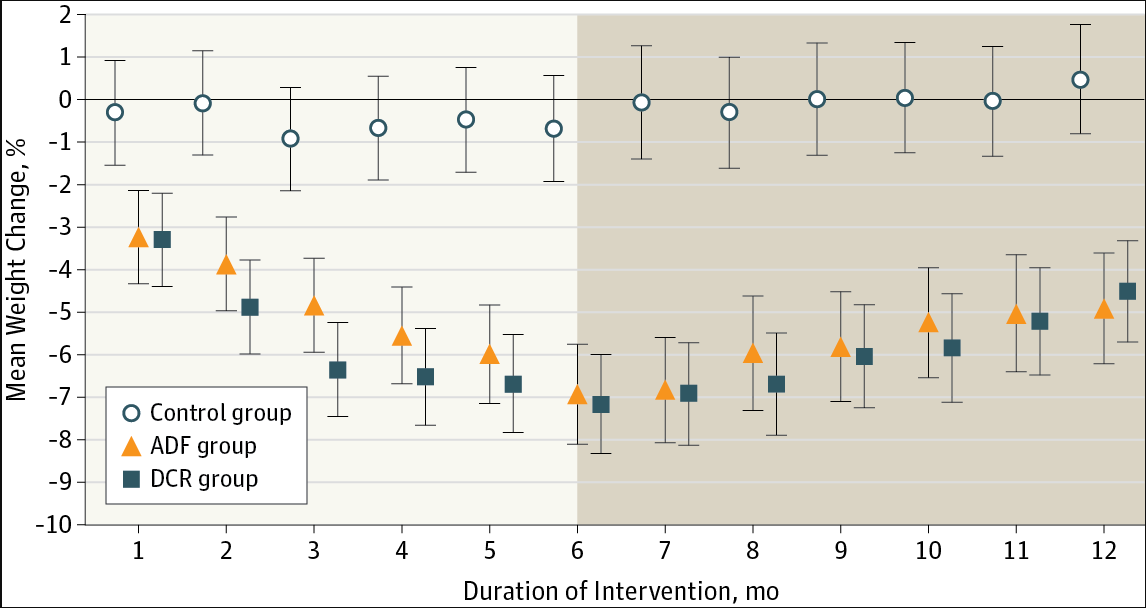Much like the search for the Fountain of Youth is the search by our overweight population for the "best" way to lose weight. Is it the low carb diet, the grapefruit diet, or the Zone diet? A relatively new approach is intermittent fasting in which the potential "loser" eschews eating for a specified number of days per week. Does this type of approach work any better than the others? A new study, just reported in JAMA Internal Medicine, targeted this mechanism. Dr. John F. Trepanowski from the University of Illinois at Chicago and colleagues recruited 100 obese adults (18-64 years old, mean BMI of 34, 86 women) to test the hypothesis that intermmittent energy restriction would lead to greater weight loss than would continuous energy restriction.
The participants were randomly assigned to either maintaining their usual diet (the control group) with no attempt to lose weight; alternate day "fasting" — only 25 percent of calorie needs on fast days and 125 percent of calorie needs on "feast" days; or continuous energy restriction — 75 percent of calorie needs every day. Thus the two intervention group consumed an average of 75 percent of calorie needs — the intake was just distributed differently. The weight loss phase of the study continued for 6 months, and then the maintenance of weight loss was assessed after another 6 months. The energy needs of the individual was determined by the doubly labeled water method (1), and this value was the basis for each person's restriction. All meals were provided for the first 3 months of the restriction study, and then participants were instructed by dietitians on how to continue their restrictions on their own, and their intake was monitored by 7-day dietary records.
At the end of the 6 month period, the average weight loss was similar in the two dieting groups — each lost 6.8 percent of their initial body weights (see graph below). Interestingly, the alternate day fasting group were not very accurate at maintaining their prescribed dietary formulas — they ate more than they were supposed to on fast days and less than they were supposed to on feast days. So overall they achieved an energy restriction of about 21 percent, while that of the constant restriction group was about 24 percent — thus there was no significant difference in restriction level, as was planned.

Source: JAMA Intern Med. Published online May 1, 2017. doi:10.1001/jamainternmed.2017.0936
By the end of the 12 month study, there were no significant differences between the restricted groups in terms of markers of cardiovascular health, such as LDL cholesterol levels.
What did differ between groups was the retention of participants in the study. In the alternate day fasting group, 13 of the 34 (38 percent) initial participants dropped out, compared to 10 of 35 (29 percent) in the constant restriction group, and 8 of 31 (26 percent) in the control group.
The authors concluded "The alternate-day fasting diet was not superior to the daily calorie restriction diet with regard to adherence, weight loss, weight maintenance, or improvement in risk indicators for cardiovascular disease."
So the results of this study indicate that tweaking the pattern of calorie restriction — alternate day restriction vs constant restriction — made no difference in the amount of weight lost or the degree to which that weight loss was maintained. This makes sense, since the degree of calorie restriction was similar in the two groups.
Another "magic bullet" bites the dust.
1) Doubly Labeled Water technique: This is a technique to asses energy expenditure. A person drinks water labeled with 2 stable (non-radioactive) isotopes: 18O and 2H. The concentration of these will decrease with time as both water and carbon dioxide (CO2) are lost from the body. The oxygen isotope is lost as both CO2 and as H2O, while the hydrogen isotope is lost only as water. The difference in loss between the two isotopes reflects the CO2 production during the measurement period, and this is a result of the body's metabolism of foods and thus gives an index of energy expenditure.




